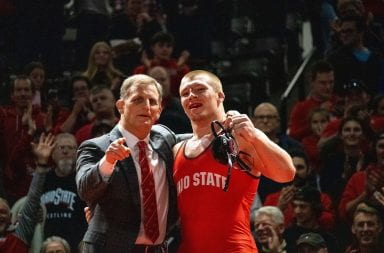Campus redevelopment plans for Ohio State, including a removal of St. John Arena and an addition of one million square feet to campus, were unveiled on Thursday.
The plans, under an initiative called Framework 2.0, have been in development since 2015, however concrete details have not been shared until now.
The plan includes a proposal for the St. John Arena site including an eventual demolition of the building which would then be replaced by academic buildings as well as outdoor recreational use.
While previous proposals had indicated overhauling the entire site at once, it is now more likely that building will be done in stages, with the arena itself continuing to stand for the foreseeable future. However, university spokesman Chris Davey, said the demolition of St. John Arena will not be immediate.
Jay Kasey, the senior vice president of Ohio State Administration and Planning said the plan could potentially add about one million square feet to campus in order to support a growing student and faculty population, as well as meet the demands of the growing research institute.
“We need to stay ahead of (students) so that we can keep them challenged,” Kasey said. “In our research area, we’re looking at the potential of about 12 percent more growth in facility square footage than we were looking at six years ago. This is because we’re upping our research commitment, our research goals.”
Kasey also said that there is a 26 percent growth envisioned for student support space, meaning study areas, lounges and general room for various activities.
The proposal also includes plans to revamp 15th Avenue and High Street to connect the streets, making for a long open stretch from the east side of High Street to Thompson Library.
“In the future … it’s seen as having a very active public square surrounded by cafes, restaurants, and several brand new buildings,” said Keith Myers, associate vice president of planning and real estate. “One of the things the plan for 15th and High does is allow a very strong connection between the university and the university district neighborhood.”
In the academic portion of campus, a realignment of Irving Schottenstein Drive is proposed, including new facilities and athletic centers around the intersection at Fred Taylor Drive.
“This will help with the interaction of student athletes,” said Myers, adding that a new ice house and indoor track facility were also proposed.
One of the major changes to the area will involve the relocation of Cannon Drive several hundred feet westward, toward the Olentangy River, opening up 12 acres for development on the health sciences campus.
Despite adding facilities, Myers emphasized that the river and some of the natural surroundings of the area will continue to be a focus.
“This district will always be an urban place but it has wonderful little green spaces that it is built around,” he said.
For the agriculture campus, four new facilities are proposed, including offices, research facilities and a new dairy barn.
The medical campus is proposed as the site of a 750,000 square foot multidisciplinary research center.
“This site came to mind as it is conveniently located between the Wexner Medical Center and the academic core (of campus),” Myers said.
Further development along Kinnear Road is in the proposal as well.
“It could be the place where we locate industry partners, that are tied to the research here at the university and possibly create a mixed-use development that would allow researchers, staff and faculty to live in the area,” Myers said.
The Framework plan also seeks to connect different areas of campus to each other.
Annie and John Glenn Avenue could possibly be extended to behind the stadium in order to connect west campus to the academic core, said Myers.
Myers said the Avenue could also possibly be renovated to bridge over the freeway and railroad track and connecting the Martha Morehouse Medical Plaza.
Small spaces on campus are not being overlooked, however, said Myers.
“We were very concerned that the smaller spaces also receive some attention,” Myers said. “So the spaces between the buildings that make a campus, they’re equally as important as some of these big moves and so there was an emphasis on trying to find those.”
The proposal also involves the elimination of many surface parking lots.
“As surface parking comes out, we’ll be looking to put in structures and we’ll continue to evaluate the need,” Myers said. “That whole question is changing rapidly as we move toward autonomous vehicles and I’m not quite sure 20 years from now just where all that ends up.”
Framework 2.0 has included conversations and meetings with faculty, staff and students to ensure that all voices are heard.
Two students, Tim Villari, a third-year in economics and Derek Whiddon, a third-year in economics and political science, met with a team each month to discuss Framework plans and topics.
Whiddon said their role on the committee is to ensure that all students had their input heard in the framework 2.0 process.
“Tim and I have been able to bring a student perspective to the aspects of Framework 2.0 and to make suggestions on its eventual implementation,” Whiddon said.
Whiddon and Villari are both members of the Undergraduate Student Government.
While the framework is sprawling, Myers emphasized the ongoing nature of the development process.
“Planning is not episodic. It’s continuous,” he said. “You don’t do a plan for 20 years, then for 20 years build it and start over. It’s a very continuous process, especially in a place that changes as quickly as the Ohio State University.”


